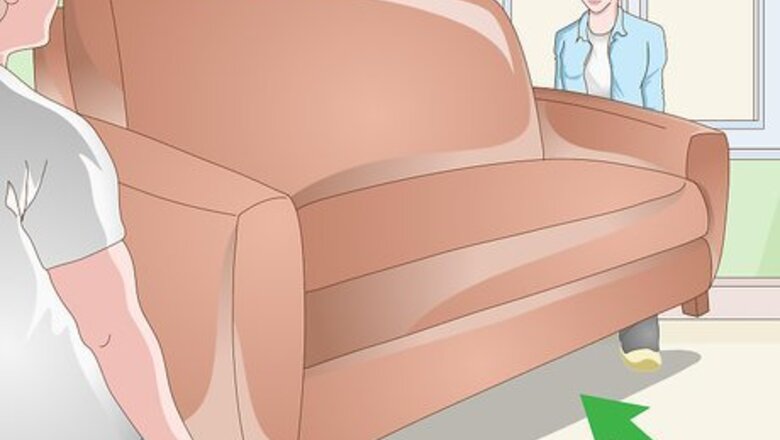
views
Cleaning and Deglazing the Leather
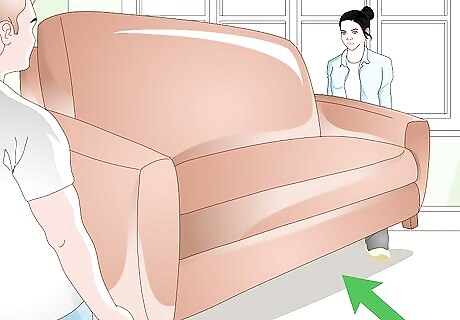
Carry the leather couch to a well-ventilated workspace. You will be working with chemicals that you should avoid breathing in. A basement, garage or outdoor driveway will provide a good place to work and keep chemical fumes out of your living space. You can also wear a mask to avoid breathing in fumes. If you must work in your living space, open as many windows and doors as possible and run a fan to ventilate the space.
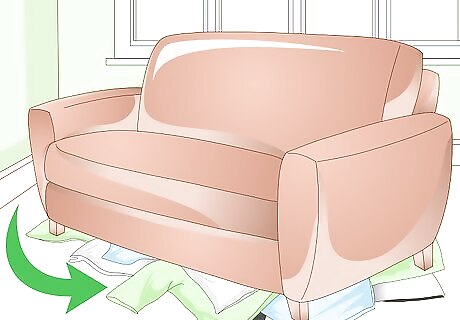
Place the couch on top of drop cloths and take off any cushions. Use a drop cloth to protect the surface or floor you are working on. Leather dye can stain many surfaces, so make sure your floor is covered before you begin. It's best to dye cushions separately from the couch itself, also over a drop cloth. You can also use old clothes or rags if they completely cover the space under your couch.
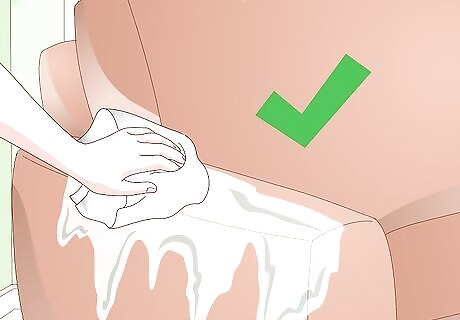
Clean the entire couch with soapy water. Remove any dust or dirt that is on the leather using a cloth and soapy water. Use a mild detergent. Do not soak the couch, as this can warp the leather. Lightly rub it with a cloth that you dip in the water and wring out. You can try to get any stains out of your leather at this point. If they are light, the dye will probably cover them up. However, dark, noticeable stains might make your final dye job look uneven. White vinegar or rubbing alcohol can get rid of most stains.
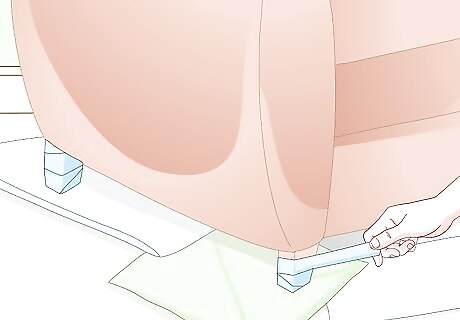
Protect any wood or hardware with painter's tape. If there is any part of your couch that you do not want to dye, such as wooden or metal hardware, cover it with painter's tape. Place the tape as close to the edge of the leather as possible. If you need to, cut the painter's tape to a smaller size to make it fit in any small nooks and crannies.
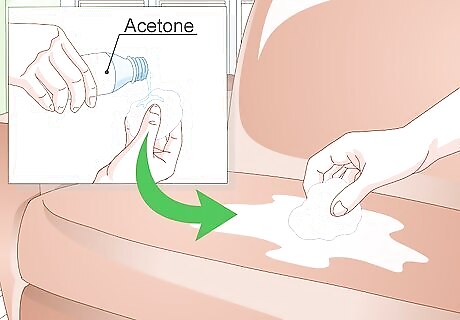
Deglaze the leather using a deglazer or acetone. Most leather furniture will have a protective coating to seal in dye and protect the leather. You can remove this, along with any lingering oils, by using a clean rag to rub deglazer or acetone into the surface of the couch. It will evaporate almost immediately, leaving your leather clean and ready to dye. Some of the original dye may rub off of the leather as you deglaze it. You can buy leather deglazer online or at most hardware stores. Use acetone (not nail polish remover) for a less expensive but equally effective solution. Avoid using products with alcohol or mineral spirits, as these will dry out the leather. EXPERT TIP Mallika Sharma Mallika Sharma Certified Leather Care Technician Mallika Sharma is a Certified Leather Care Technician and the Founder of The Leather Laundry, a niche spa service for luxury leather gear in India. Mallika specializes in leather cleaning, coloring, repairing, and restoring for shoes, handbags, jackets, wallets, belts, and sofas. She holds a Master’s degree in Finance and Investment from the University of Edinburgh Business School. Mallika is a certified Professional Leather Care Technician and trained with the globally reputed leather care company, LTT in the United Kingdom. Mallika Sharma Mallika Sharma Certified Leather Care Technician Prep leather before painting it. Properly preparing the surface of leather before painting it helps the color fully absorb for a smooth, even finish. First clean the leather thoroughly with a solvent like thinner, rubbing alcohol or ammonia to open up and clear out the pores. Then, airbrush on leather paint, followed by applying a fixing agent or sealant on top to properly set and seal in the painted color.
Applying the Dye
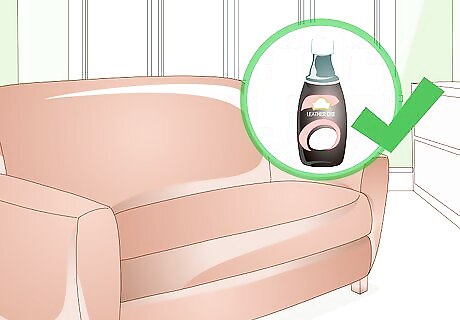
Purchase leather dye in the color you want your couch to be. You can find leather dye at a specialty leather shop, at some craft stores, or online. You can easily dye a light leather to look darker, but making a dark leather couch look lighter is more difficult. Avoid dying a black or very dark couch a light color. For medium dark colors, expect to apply more layers of dye. Combine colors if you can't find a dye in the exact shade you are looking for. For example, if you want a dark brown but the brown dye seems too light, mix a little black die into it. Use white dye to get a lighter color.
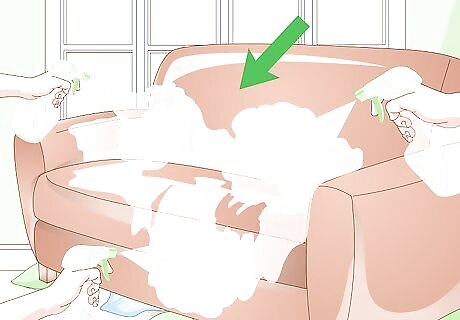
Spray a small section of the leather couch, about the size of your hand, with a water bottle. Getting the leather slightly wet will help it absorb the dye. Start by spraying a small section of the leather, because you will dye it in small sections. Avoid completely soaking the leather because this can cause it to stain or warp. If the leather is unevenly wet, it will absorb the dye unevenly.
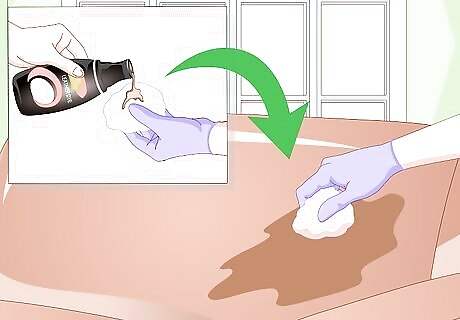
Apply the dye in a thin coat to small sections at a time. Some leather dyes come with wool daubers you can use to apply them. You can also use a new sponge, which works well to spread the dye evenly. Place a drop or two of dye on a wool dauber or sponge and spread it over the leather using parallel strokes, making sure to get all the nooks and crannies. A little bit of dye goes a long way, so don't use more than a few drops at a time, or the dye will drip and run down your furniture. Work in small sections at a time. For instance, do each arm, then each cushion, then divide the top and back into small, equal sections. Be sure to spritz each area with water before applying the dye. Wear gloves to protect your hands from the dye. Don't worry about trying to get an even dye job on the first coat. Any streaks or unevenness will be less visible as you apply more coats.

Let the color dry for 1 hour and then apply 2-5 additional coats. You don't need to dampen the leather with water again after doing the first coat. Apply as many coats as you need to get the color you are looking for. Most leather couches will need between 3 and 6 coats total. Let each coat dry completely before applying another. If you are attempting to dye a dark couch lighter, you might need to apply more coats. If you apply too much dye, it will look metallic or too shiny. To remove excess dye, soak a rag in rubbing alcohol and run it over the affected area. Keep in mind that no matter how careful you are, hand dying leather will result in a slightly uneven look. If the dye is significantly darker in one spot, use rubbing alcohol to take off some of the excess dye.

Apply a finisher to the leather once the last coat of dye is dry. Finisher will seal in the dye and protect it from fading. Give your couch at least 1 hour to dry completely after applying the final coat of dye. Spray the finisher on the leather couch and rub it in with a damp, clean rag. Use long strokes to evenly coat the surface of the leather with finisher. Finishers usually dry in about 3 hours. You can move the couch back into your living space and start using it again once the finisher is dry. Leather finisher can be purchased wherever you buy leather dye. It may also be called leather top coat. Choose a glossy finish for more shine or satin finish for a more matte result.


















Comments
0 comment